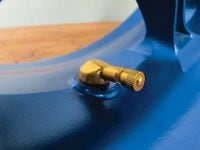WRIST: Zack Courts
MSRP (2015): $16,490
MILES: 1,483
MPG: 33
MODS: BikeMaster valve stems
Since our superbike test a couple of months ago (see Superbikes 2015 here), we haven't really had any sportbikes around. That means everything I've been riding aside from the R1 is comparatively docile and, for the most part, relatively comfortable. Even still, when I scurry out of the building and head for home on the R1, I'm more enamored with the velvety sound of the engine than I am sad about the riding position. So far, the ergos don't leave me in a weeping pile of complaints after every ride.
I tagged along to a trackday that two of my colleagues were attending to get suspension sorted out. I wanted to sample the base R1’s KYB suspension while the up-spec Öhlins kit from the R1M we used in the superbike test was still fresh in my mind. I went through and made sure all of the settings were at stock baseline, and after a few sessions on the track I was quite satisfied. I may take some damping out to soften the ride on the street, but I’m going to ease into that.
In prepping for the track, I tackled the R1 with a wrench for the first time. Deletion of the passenger pegs is basic and easy, though not as easy as it could be. The layers of plastic covers and sheaths that need to be removed to gain access to anything that attaches to the subframe reminded me of a puzzle at a science museum. Tiny bolts and screws abound. Mirror removal, on the other hand, was a treat considering the front turn signals are integrated. A panel peels back to expose a simple connector, and once unplugged it’s smooth sailing to take the mirrors off and gain a sleek, track-ready aesthetic.
A painful lesson was learned at the track when I checked hot tire pressure. With the R1’s huge, 320mm front rotors still holding hundreds of degrees I struggled to get the pressure gauge around the valve stem without searing my digits. Leaving the track with my left hand looking like an overcooked Whopper, my right hand cradled my iPhone and quickly found a solution.
BikeMaster's angled aluminum valve stems (bikemaster.com) seemed like they would do the trick, and I was impressed with the price: $20 for a pair. Swapping back to street tires, I cut the stock stems off and quickly installed the aluminum set. They're in two pieces, sealing with a rubber O-ring squeezed by a 14mm nut. BikeMaster sells them in five colors, including blue, but I had a hunch it would be tough to match the wheels perfectly, so I went with gold. I think it accents the gold fork tubes nicely. Plus, when you're looking for the valve stem on the wheel you want it to be easy to find! Checking pressures is easier now, with sturdier aluminum and the stem pointing the right direction. I'm sure it'll pay off at the next trackday as well as in the meantime.
Next up, I hear Yamaha is going to offer the Communication Control Unit (CCU) from the R1M for installation on the base R1. The CCU allows the rider to track and log data from a ride, whether it’s street or closed circuit, and analyze it later. Perfect to geek out on at a trackday, and it could be interesting for the street too.













/cloudfront-us-east-1.images.arcpublishing.com/octane/IIGGWFOTOJGB7DB6DGBXCCMTDY.jpg)
/cloudfront-us-east-1.images.arcpublishing.com/octane/QSTCM6AVEZA5JJBUXNIQ3DSOF4.jpg)
/cloudfront-us-east-1.images.arcpublishing.com/octane/U4I7G625B5DMLF2DVIJDFZVV6M.jpg)
/cloudfront-us-east-1.images.arcpublishing.com/octane/B6XD6LS6IVCQPIU6HXDJSM3FHY.jpg)
/cloudfront-us-east-1.images.arcpublishing.com/octane/ICL63FEDDRDTTMINYICCEYGMDA.jpg)
/cloudfront-us-east-1.images.arcpublishing.com/octane/FCGZHQXRBZFLBAPC5SDIQLVF4I.jpg)
/cloudfront-us-east-1.images.arcpublishing.com/octane/WNOB6LDOIFFHJKPSVIWDYUGOPM.jpg)

/cloudfront-us-east-1.images.arcpublishing.com/octane/X33NU3E525ECRHXLNUJN2FTRKI.jpg)
/cloudfront-us-east-1.images.arcpublishing.com/octane/6KKT5NNL2JAVBOXMZYS5ZO76YA.jpg)
/cloudfront-us-east-1.images.arcpublishing.com/octane/J5RKG5O455GMPGQRF2OG6LRT7A.jpg)
/cloudfront-us-east-1.images.arcpublishing.com/octane/GX2CIZKQVRH2TATDM26KFG2DAE.jpg)
/cloudfront-us-east-1.images.arcpublishing.com/octane/ZWIDYSAKQZHD5BHREMQILXJCGM.jpg)
/cloudfront-us-east-1.images.arcpublishing.com/octane/CYUHJZCTSJCH3MRAQEIKXK7SCQ.jpg)
/cloudfront-us-east-1.images.arcpublishing.com/octane/LKOFINY56FCXJCANJ5M7ZDQUBY.jpg)
/cloudfront-us-east-1.images.arcpublishing.com/octane/4NBPDACMWJH63JQYJVK3QRBDZI.jpg)
/cloudfront-us-east-1.images.arcpublishing.com/octane/KKHQHRR3FJGX7H2IPU6RALMWG4.jpg)

/cloudfront-us-east-1.images.arcpublishing.com/octane/5IOFS5JAE5FOXMNA23ZRAVVYUU.jpg)
/cloudfront-us-east-1.images.arcpublishing.com/octane/CGXQ3O2VVJF7PGTYR3QICTLDLM.jpg)

/cloudfront-us-east-1.images.arcpublishing.com/octane/OQVCJOABCFC5NBEF2KIGRCV3XA.jpg)
/cloudfront-us-east-1.images.arcpublishing.com/octane/OPVQ7R4EFNCLRDPSQT4FBZCS2A.jpg)
/cloudfront-us-east-1.images.arcpublishing.com/octane/YBPFZBTAS5FJJBKOWC57QGEFDM.jpg)